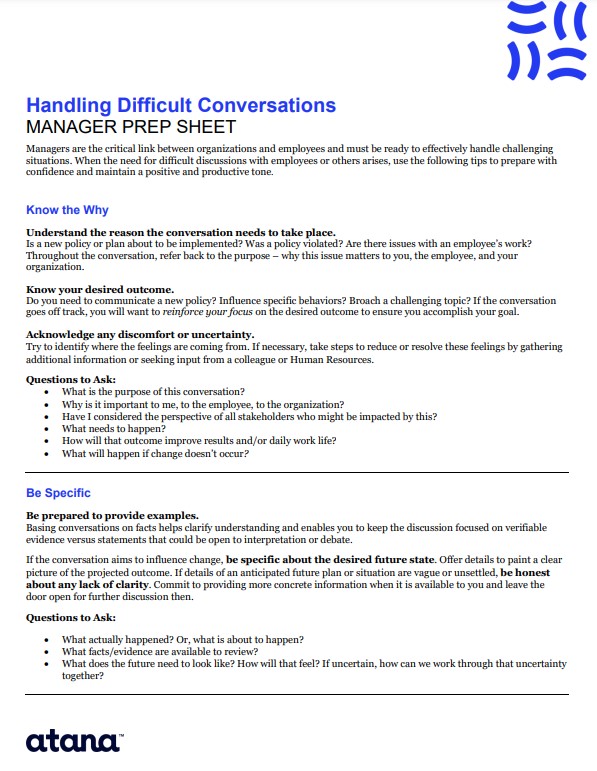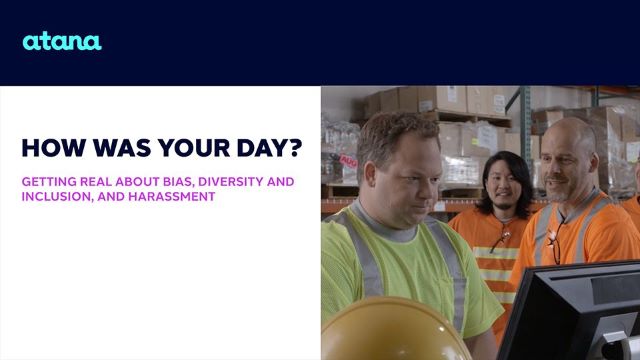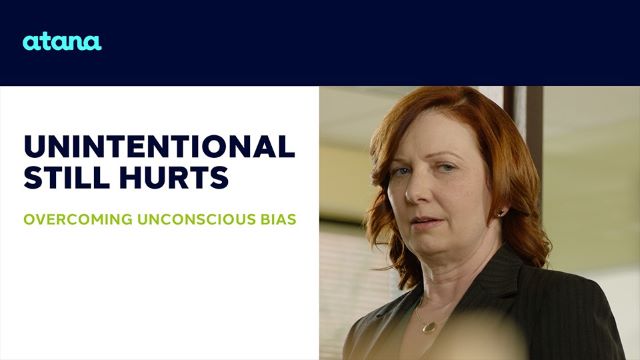
Because managers are the critical link between organizations and employees, they must be ready to effectively handle challenging situations. That includes having conversations that may be uncomfortable or difficult.
When those discussions with employees or others arise, use these tips to prepare with confidence and maintain a positive, productive tone.
1. Know the Why
Understand the reason the conversation needs to take place. Is a new policy or plan about to be implemented? Was a policy violated? Have issues about an employee’s work arisen? Throughout the conversation, refer back to the purpose – why this issue matters to you, the employee, and your organization.
Know your desired outcome. Do you need to communicate a new policy? Influence specific behaviors? Broach a challenging topic? If the conversation goes off track, you will want to reinforce your focus on the desired outcome to ensure you accomplish your goal.
Acknowledge any discomfort or uncertainty you may feel going into the meeting. Try to identify where the feelings are coming from. If necessary, take steps to reduce or resolve these feelings by doing research to gather additional information or seeking input from a colleague or Human Resources.
Questions to Ask
• What is the purpose of this conversation?
• Why is it important to me, to the employee, to the organization?
• Have I considered the perspective of all stakeholders who might be impacted by this?
• What needs to happen? How will that outcome improve results and/or daily work life?
• What will happen if change doesn’t occur?
2. Be Specific
Be prepared to provide examples of issues or of behaviors to be addressed. Basing conversations on facts helps clarify understanding and enables you to keep the discussion focused on verifiable evidence versus statements that could be open to interpretation or debate.
If the conversation aims to influence change, be specific about the desired future state. Offer details to paint a clear picture of the projected outcome. If details of an anticipated future plan or situation are vague or unsettled, be honest about any lack of clarity. Commit to providing more concrete information when it is available to you and leave the door open for further discussion then.
Questions to Ask:
• What actually happened? Or, what is about to happen?
• What facts/evidence are available to review?
• What does the future need to look like? How will that feel? (If uncertain, how can we work through that uncertainty together?)
3. Listen with an open mind
Be an active listener and observer. Pause often during the conversation and assess the employee’s reactions. Stay aware of tone and word choices (your own and the employee’s) as indicators of underlying messages. Ask questions and summarize what you heard to clarify and check your understanding.
Remember the importance of body language (your own and the employee’s) in this communication. Maintain open and relaxed positions to help defuse tension.
Practice curiosity. Keep an open mind and welcome the opportunity to learn, and to understand the employee’s point of view. Pay particular attention to expressed concerns, fears, and uncertainties. Respond to those emotions calmly and factually. If the employee brings up issues you feel need investigation, make a commitment to do so.
Throughout the conversation, assume the employee’s positive intent—especially if the tone becomes heated or tense. Recognize that such elements may be emotion-driven, and that the employee may tend to feel defensive simply because of the manager/worker dynamic.
At the same time, be prepared for possible pushback. Understand that the employee may try to sidetrack or divert a discussion away from the problem, especially if they feel defensive or fearful. While a manager should always enable an employee to be heard, keeping the conversation focused and constructive is a leadership must.
Questions to Ask:
• What can I learn from the employee’s perspective?
• Have I made an honest effort to identify any potential biases I might bring to the conversation?
• Am I remembering to stop periodically and ask questions or summarize what I think I’ve heard?
• Am I taking care to choose my own words carefully and to maintain a neutral tone and body language?
4. Focus on solutions
Difficult conversations can reach satisfying conclusions when those involved work together to find solutions. Ask the employee what outcome they envision. What would they like to hear you say or hope that you might do? Collaborating on an outcome can strengthen your connection and emphasize agreement instead of disagreement.
Be open to the idea that an appropriate outcome may differ somewhat from the solution you’d originally envisioned. Finding compromises or making adjustments to address the employee’s concerns may result in a better solution and one that is more likely to succeed because the employee is invested in it.
Don’t conclude the conversation without making a commitment to take action. Be clear about next steps and the responsibilities of all parties. Understand how those accountabilities will be monitored and adhered to. Make sure that any necessary documentation is executed.
Follow up after the conversation. Express your appreciation for the opportunity to have an honest interaction and for the employee’s contributions to the conversation and to the solution. Thank them for joining you in a commitment to act and drive change. If the conversation must continue at a later time or be revisited, establish when that will occur.
Questions to Ask:
• How can we work together to create solutions that will be mutually satisfying?
• If compromises are made, how will that affect me, the employee, our team/department, and the organization?
• Are the perspectives of all who could be affected being considered and addressed?
• How will I follow through on the agreed-upon solution(s)?
• Does this conversation need to be revisited in the future? If so, when and why?
Recommended Training
Atana equips managers for today's toughest conversations through manager-specific courses on DEI, unconscious bias, harassment prevention and workplace violence prevention.
Once & For All
Sexual Harassment
How Was Your Day?
Bias, DEI and Harassment
Unintentional Still Hurts
Unconscious Bias








